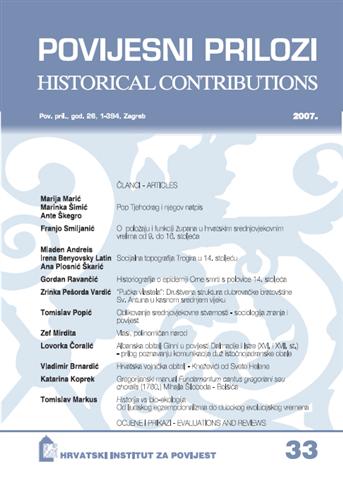Gregorijanski manual Fundamentum cantus gregoriani seu choralis (1760.) Mihajla Šiloboda – Bolšića
The Gregorian plainsong manual Fundamentum cantus gregoriani seu choralis (1760) by Mihajlo Šilobod-Bolšić
Author(s): Katarina KoprekSubject(s): History
Published by: Hrvatski institut za povijest
Keywords: music; dialogue; musical-pedagogical-methodological guidelines; music theory; Gregorian plainsong; the emergence of music; solmisation; intervals; tones; intonations
Summary/Abstract: Music, the oldest form of human culture, is not only deeply rooted in religion but also possesses social and pedagogical-moral power. Philosophers and music scholars since the Antiquity have argued that music has both pedagogical and ethical functions. These features of music shaped and influenced human consciousness. Openness to communication is one of the fundamental strengths of the music’s spiritual power. Music may, thus, be seen as an invitation to communicate—not only for its sound expression but also for its semantic tenets and theoretical discourse. The ‘dialogue-shaped’ Šilobod-Bolšić’s treatise Fundamentum cantus gregoriani seu choralis (1760) thus comes out of a long tradition. This piece is crucially important and interesting in the first place as a historic testimony of the Croatian musical Gregorian- plainsong tradition. Yet the dialogue form does not constitute a novel phenomenon in the musicological scholarship. It was probably modelled after the Roman Catholic catechism. Here the learning is organized in the form of a series of questions and answers. From the Middle Ages onwards, music scholars have presented their knowledge in the form of a dialogue between the teacher and the student. The form, thus, aims to draw attention to the connections between musicological research and its theoretical knowledge and laws, as well as to the religious foundations of music and its educational and moral contribution to human development. Thinking together through music, furthermore, enables reaching a level of understanding that is hard to access without the help of dialogue. The treatise Fundamentum cantus gregoriani seu choralis (1760), as a whole, purports to be a musical textbook, containing not only important philosophical-theological but also musical-pedagogical-methodological directives. It radiates spiritual depth, creative innovativeness and the cultural breadth of the author. The treatise is a simplified synthesis of older musical theoretical scholarship, mostly by philosophers and theologians such as Plato, Plotinus, Boethius, Thomas Aquinas, and, especially, St Augustine. Fundamentum cantus gregoriani seu choralis consists of six dialogues discussing the emergence of music and singing (first dialogue); staff, notes and keys (second dialogue); on solmisation (third dialogue); on intervals (fourth dialogue); on authentic and plagal tones (fifth dialogue); on intonations (sixth dialogue).
Journal: Povijesni prilozi
- Issue Year: 2007
- Issue No: 33
- Page Range: 311-330
- Page Count: 19
- Language: Croatian

